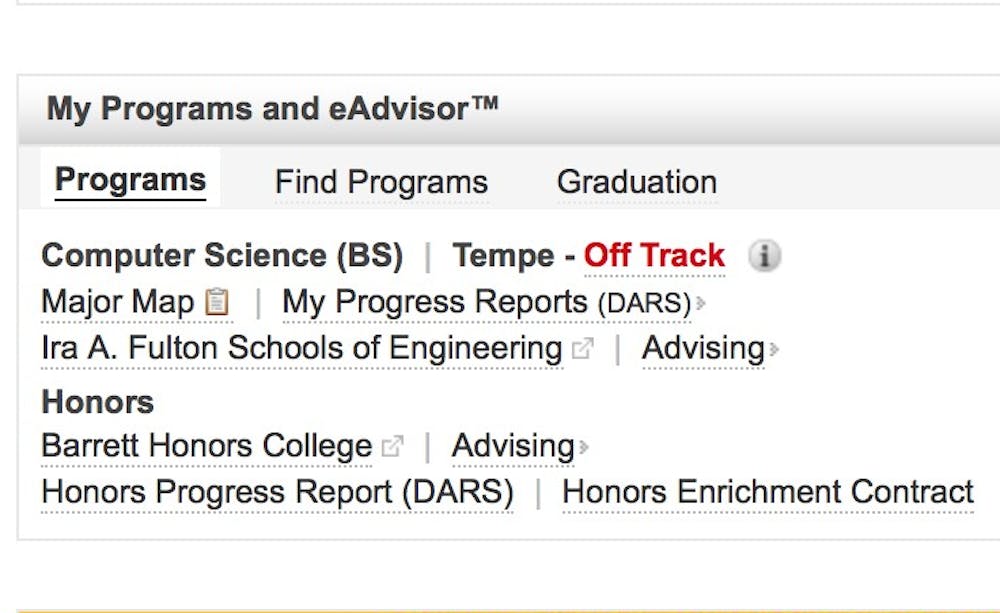Declaring an exploratory major is becoming less common for incoming freshman but more common for students finding themselves off-track in another major, according to ASU’s exploratory program.
Robert Monahan, assistant director of First Year Programs for the College of Liberal Arts and Sciences, said more students are using the exploratory program when they struggle to complete required classes for their major.
However, a student cannot transfer into the exploratory major if he/she has more than 45 credit hours. So that means a junior or senior is generally ineligible.
Monahan gave the example of business majors switching to exploratory after struggling with certain prerequisite math classes that left them off-track to graduate, and in risk of being dropped from their program.
“If they don’t make the Carey School, we don’t want them to think they’re destitute because that’s just not the case,” he said.
Senior Associate Dean with the Fulton Schools of Engineering James Collofello said some students aren’t successful in the engineering program because they struggle to complete the program’s technical requirements like math and physics.
But Collofello said the Fulton Schools retain about 75 percent of its freshman class, and said most students who struggle with technical classes change to a major within the engineering school that doesn’t have the same requirements for graduation.
He said it’s more common for students to take that route as opposed to switching into the exploratory program — even though the exploratory program does offer a track for mathematics, technology, engineering and physical science.
The exploratory program doesn’t require students to pick a specific major, but they do have students choose an exploratory track — either fine arts, humanities and design, health and life sciences, mathematics, technology, engineering and physical science, or social and behavioral sciences.
Social and behavioral sciences is currently the most popular track with 640 students. Mathematics, technology, engineering and physical science is next with 202 students. Health and life sciences has 125 students, and 82 students are in humanities, fine arts and design.
Monahan said exploratory advisers try to help students figure out how they can continue to pursue what they’re passionate about while understanding that there’s more than one way to be successful.
But he also said the goal is to make sure students can find an alternate program that will still allow them to graduate within four years.
“When they leave college in debt without getting a degree, that scares me,” he said. “There’s always a Plan B.”
While exploratory might not be a first option for many freshman students, Monahan said if a student isn’t sure what they want to major in, exploratory is a better route than picking a major randomly.
“If they don’t know, we don’t want them to pretend,” he said.
That’s because Monahan said students who start out in the exploratory program generally change majors less than the average three times during a student’s college career.
That means they’re less likely to spend extra time and money making up credits that don’t transfer to their new degree when they switch majors.
But switching majors doesn’t always lead to debt.
Eric Arellano is a freshman double majoring in computer science and innovation and society.
He was majoring in sustainability but decided to switch because he thought a computer science degree would help him in the specific area of sustainability he wants to pursue.
“I will be able to make more of a difference in sustainability by studying computer science and transferring those skills to sustainability as opposed to just studying sustainability,” he said.
He stressed that his mission is to “leverage technology for the social good,” and that he believes switching majors is the best way to pursue that.
However, he said that’s not to say the change didn’t worry him.
He was initially concerned that the amount of credit hours required for a computer science degree would mean he wouldn’t have time to take non-required elective classes he enjoys.
He said he needed 46 credits to complete a sustainability degree, whereas he now needs 82 credits to complete his computer science degree.
Arellano decided to pursue computer science and continue taking elective credits, and says it will mean graduating a year later.
He said he doesn't mind, however. He’s received enough scholarship support that he’ll be able to stay an additional year without taking out loans.
Only three of his freshman year credits will not transfer into his computer science degree because he took several universal prerequisites like Barrett’s required courses and ASU 101.
Arellano said it would have been harder to transfer as an upperclassman, and believes transferring into the engineering program as a freshman hasn’t placed him behind his peers.
Collofello said in general, engineering might be a difficult program to switch into because few other schools within ASU are as rigorous and technical, but it’s not impossible.
“It’s probably easier to switch out of engineering than to switch in,” he said. “But the success of any student depends on their goals and passions.”
Related links:
Don't discriminate against others based on their major
Point: earning a major in college sports should no longer be a joke
Reach the reporter at brieanna.frank@asu.edu or follow @brieannafrank on Twitter.
Like The State Press on Facebook and follow @statepress on Twitter.




